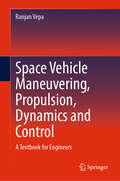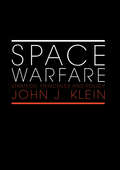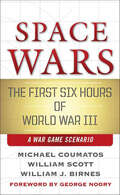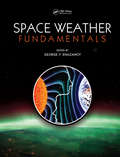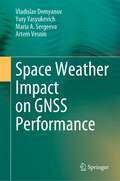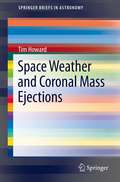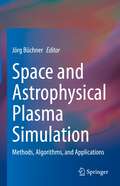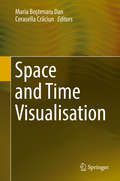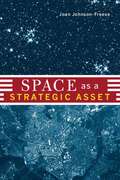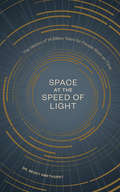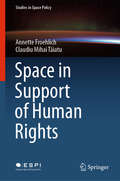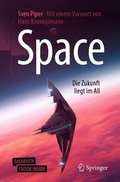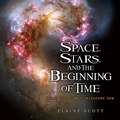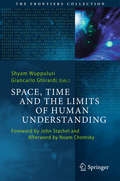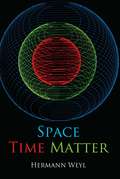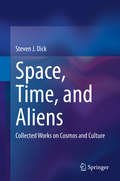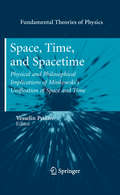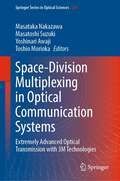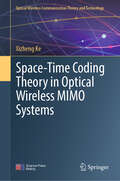- Table View
- List View
Space Vehicle Maneuvering, Propulsion, Dynamics and Control: A Textbook for Engineers
by Ranjan VepaThis textbook introduces space vehicle maneuvering, propulsion, dynamics and control, and discusses the space environment and its influence on the spacecraft propulsion system. This is followed by an in depth description of Keplerian celestial mechanics, co-planar and non-planar orbital transfers involving both impulsive and continuous manoeuvers, and perturbation effects that characterize the real non-Keplerian nature of orbital motion. Dr. Vepa then explains the use of restricted two-body and three-body dynamics as descriptors of spacecraft motion, the limitations of these approach in terms of orbital perturbations and an understanding of the physical source and influence of these perturbations, and principles of the optimal synthesis of trajectories. Featuring many exercises, design case studies, and extensive use of MATLAB/SIMULINK and MATLAB analytical tools, the book is ideal for graduate students, post graduate students, researchers, as well professionals in the industry.
Space Warfare: Strategy, Principles and Policy (Space Power and Politics)
by John J. KleinThis new study considers military space strategy within the context of the land and naval strategies of the past. Explaining why and how strategists note the similarities of space operations to those of the air and naval forces, this book shows why many such strategies unintentionally lead to overemphasizing the importance of space-based offensive weaponry and technology. Counter to most U.S. Air Force doctrines, the book argues that space-based weapons don’t imbue superiority. It examines why both air and naval strategic frameworks actually fail to adequately capture the scope of real-world issues regarding current space operations. Yet by expanding a naval strategic framework to include maritime activities—which includes the interaction of land and sea—the breadth of issues and concerns regarding space activities and operations can be fully encompassed. Commander John Klein, United States Navy, uses Sir Julian Corbett’s maritime strategy as a strategic springboard, while observing the salient lessons of other strategists—including Sun Tzu, Clausewitz, Jomini, and Mao Tse-tung—to show how a space strategy and associated principles of space warfare can be derived to predict concerns, develop ideas, and suggest policy not currently recognized. This book will be of great interest to all students and scholars of military and strategic studies and to those with an interest in space strategy in particular.
Space Wars: The First Six Hours of World War III, a War Game Scenario
by William J. Birnes William Scott Michael CoumatosMichael J. Coumatos is a former U.S. Navy test pilot, ship's captain, and commodore; U.S. Space Command director of wargaming; and a government counterterrorism advisor. William Scott is a retired bureau chief of Aviation Week and Space Technology and a nine-year Air force veteran who served as aircrew on nuclear sampling missions. He is a six-time Royal Aeronautical Society "Journalist of the Year" finalist, and won the Society's 1998 Lockheed Martin Award for the "Best Defense Submission." He also received both the 2006 and 2007 Messier-Dowty awards for "Best Airshow Submission." With the help of New York Times bestselling author William J. Birnes, these renowned experts have joined forces to grippingly depict how the first hours of World War III might play out in the year 2010.Coumatos, Scott, and Birnes take the reader inside U.S. Strategic Command, where top military commanders, space-company executives, and U.S. intelligence experts are conducting a DEADSATS II wargame, exploring how the loss of critical satellites could lead to nuclear war. The players don't know that the war they are gaming has already begun, miles above them in the lifeless, silent cold of space. Jam-packed with the actual systems and secret technologies the United States has or will soon field to protect its space assets, Space Wars describes a near-future nuclear nightmare that terrorists will relish but politicians prefer to ignore. In a quieter, more peaceful time, Space Wars would be an exciting work of fiction. But with the United States now at war, Space Wars is all too real. .At the Publisher's request, this title is being sold without Digital Rights Management Software (DRM) applied.
Space Weapons Earth Wars
by Dana J. Johnson Michael D. Miller Robert Preston Sean J. Edwards Calvin ShipbaughThis overview aims to inform the public discussion of space-based weapons by examining their characteristics, potential attributes, limitations, legality, and utility. The authors do not argue for or against space weapons, nor do they estimate the potential costs and performance of specific programs, but instead sort through the realities and myths surrounding space weapons in order to ensure that debates and discussions are based on fact.
Space Weather Fundamentals
by George V. KhazanovSpace weather is one of the most significant natural hazards to human life and health. Conditions of the sun and in the solar wind, magnetosphere, ionosphere, and thermosphere can influence the performance and reliability of space-borne and ground-based technological systems. If conditions in the space environment are adverse, they can cause disruption of satellite operations, communications, navigation, and electric power distribution grids, leading to a variety of socioeconomic losses. This book provides an overview of our current knowledge and theoretical understanding of space weather formation and covers all major topics of this phenomena, from the sun to the Earth’s ionosphere and thermosphere, thus providing a fully updated review of this rapidly advancing field. The book brings together an outstanding team of internationally recognised contributors to cover topics such as solar wind, the earth's magnetic field, radiation belts, the aurora, spacecraft charging, orbital drag and GPS.
Space Weather Impact on GNSS Performance
by Vladislav Demyanov Yury Yasyukevich Maria A. Sergeeva Artem VesninThis book addresses problems of GNSS performance support under geomagnetic storms and solar radio bursts. It analyses both physical and radio-engineering sources of GNSS performance deterioration caused by geomagnetic storms, solar radio bursts and peculiarities of the polar and equatorial ionosphere. The book takes into consideration both standalone GNSS and differential GNSS. Based on experimental data analysis, it presents a systematic approach to maintaining reliable GNSS performance despite the Space Weather impacts.Given its scope, the book offers a valuable resource for GNSS users and equipment developers, as well as researchers and students whose work involves GNSS remote sensing, surveying, navigation, and related disciplines.
Space Weather and Coronal Mass Ejections
by Tim HowardSpace weather has attracted a lot of attention in recent times. Severe space weather can disrupt spacecraft, and on Earth can be the cause of power outages and power station failure. It also presents a radiation hazard for airline passengers and astronauts. These "magnetic storms" are most commonly caused by coronal mass ejections, or CMES, which are large eruptions of plasma and magnetic field from the Sun that can reach speeds of several thousand km/s. In this SpringerBrief, Space Weather and Coronal Mass Ejections, author Timothy Howard briefly introduces the coronal mass ejection, its scientific importance, and its relevance to space weather at Earth and other planets. This title focuses on the latest advances in CME observation and modeling, including new results from the NASA STEREO and SDO missions. It also includes topical issues regarding space weather and the most recent observations and anecdotal examples of the impacts of space weather and CMEs.
Space and Astrophysical Plasma Simulation: Methods, Algorithms, and Applications
by Jörg BüchnerThis book is a collection of contributions covering the major subjects in numerical simulation of space and astrophysical plasma. It introduces the different approaches and methods to model plasma, the necessary computational codes, and applications in the field. The book is rooted in the previous work Space Plasma Simulation (Springer, 2003) and includes the latest developments. It is divided into three parts and all chapters start with an introduction motivating the topic and its use in research and ends with a discussion of its applications. The chapters of the first part contain tutorials of the different basic approaches needed to perform space plasma simulations. This part is particularly useful for graduate students to master the subject. The second part presents more advanced materials for students and researchers who already work with pre-existing codes but want to implement the recent progresses made in the field. The last part of the book discusses developments in the area for researchers who are actively working on advanced simulation approaches like higher order schemes and artificial intelligence, agent-based technologies for multiscale and multi-dimensional systems, which represent the recent innovative contributions made in space plasma research.
Space and Beyond: Professional Voyage of K. Kasturirangan
by B. N. SureshThis book discusses the journey of Dr. K Kasturirangan, who shares his experience during his long tenure at ISRO including the Chairmanship of ISRO, subsequently membership of the Rajya Sabha, the Planning Commission and many other responsibilities. Over the past five decades of public and professional service to the nation, Dr. Kasturirangan has graduated from a young researcher in astrophysics working under Vikram Sarabhai to leading India’s space program (ISRO), being entrusted by five successive Prime Ministers, besides dealing with several other domains of responsibilities beyond space, all of which have significantly impacted India’s development. This book centers around select 12 public invited lectures, Dr. Kasturirangan delivered ranging from developing hi-tech space systems, to managing an organization as intricate as ISRO which was guided by the wisdom of mentors, including Vikram Sarabhai, M G K Menon, Satish Dhawan and U. R. Rao, to tackling multi-faceted socio-economic issues, including India’s nuclear deal, report headed by him on the Western Ghats ecosystem, and the new National Education Policy 2020. Scientists, historians, policy makers, management strategists, journalists, or anyone with a keen interest in understanding the processes behind such large-scale science, technology and socio-economic endeavors – right from planning, creating appropriate institutional mechanisms, working with multiple stakeholders to ensure that these programs deliver tangible benefits to society, articulating these benefits with clarity to political leaders to assure public support – will find this book deeply instructive and illuminating. It will be of interest to the scientific, education and management community as well as to policy makers and researchers affiliated with multifaceted developmental issues.
Space and Earth Science (3rd Edition)
by Bob Jones UniversitySpace And Earth Science divides the physical (nonliving) universe into four major divisions. From the perspective of a human on Earth, these divisions can be imagined as spheres of information.
Space and Time Visualisation
by Cerasella Crăciun Maria Boştenaru DanThis book explores expertise relevant for two working groups of NeDiMAH, a European Science Foundation (ESF) funded Research Networking Programme. It examines mapping methods, procedures, tools, criticism, awareness, challenges and solutions around the concepts of "Space and Time" and "Information Visualization". The chapters explore digital methods in the representation of natural disasters, industrial design, cultural, and the history of architecture. The conclusions link to related research and present suggestions for further work including representing landscape not just as another 3D model but as historic evolution with specialised tools.
Space as a Strategic Asset
by Joan Johnson-FreeseJoan Johnson-Freese argues that the race for space weapons and the U.S. quest for exclusive or at least dominant ownership of strategic space assets have alienated the very allies that the United States needs in order to maintain its leading role in space exploration. Taking a balanced look at the issues that have contributed to the decline of America's manned space program, such as lack of political support and funding, Johnson-Freese offers not only a critique but also a plan for enhancing U.S. space security through cooperation rather than competition.She begins with a brief overview of the history of international space development through four eras: before Sputnik, the space race, after Apollo, and globalization. Then she focuses on how policy changes of the mid-1990s have changed the nation, examining why the United States has grown obsessed with the development of space technology not just as a tool for globalization but as a route toward expanding an already dominant arsenal of weapons. Johnson-Freese claims that these policy choices have greatly affected the attitudes and actions of other countries, and in the fight to achieve security, the United States has instead put itself at greater peril.Johnson-Freese explains complex technical issues in clear, accessible terms and suggests a way forward that is comprehensive rather than partisan. America is not the only country with space ambitions, but it is unique in viewing space as a battlefield and the technological advancements of other nations as a dire threat. Urgent and persuasive, Space as a Strategic Asset underscores the danger of allowing our space program to languish and the crucial role of cooperation in protecting the security of our country and the world.
Space at the Speed of Light: The History of 14 Billion Years for People Short on Time
by Dr. Becky SmethurstFrom the big bang to black holes, this fast-paced illustrated tour of time and space for the astro-curious unlocks the science of the stars to reveal fascinating theories, surprising discoveries, and ongoing mysteries in modern astronomy and astrophysics.Before the big bang, time, space, and matter didn't exist. In the 14 billion years since, scientists have pointed their telescopes upward, peering outward in space and backward in time, developing and refining theories to explain the weird and wonderful phenomena they observed. Through these observations, we now understand concepts like the size of the universe (still expanding), the distance to the next-nearest star from earth (Alpha Centauri, 26 trillion miles) and what drives the formation of elements (nuclear fusion), planets and galaxies (gravity), and black holes (gravitational collapse). But are these cosmological questions definitively answered or is there more to discover?Oxford University astrophysicist and popular YouTube personality Dr. Becky Smethurst presents everything you need to know about the universe in ten accessible and engagingly illustrated lessons. In Space at the Speed of Light: The History of 14 Billion Years for People Short on Time, she guides you through fundamental questions, both answered and unanswered, posed by space scientists. Why does gravity matter? How do we know the big bang happened? What is dark matter? Do aliens exist? Why is the sky dark at night? If you have ever looked up at night and wondered how it all works, you will find answers--and many more questions--in this pocket-sized tour of the universe!
Space in Support of Human Rights (Studies in Space Policy #23)
by Annette Froehlich Claudiu Mihai TăiatuThis book stems from the worrying scale and intensity of conflicts, humanitarian crises, and human rights violations around the world, which can be seen in a wide range of global hotspots including Venezuela, Yemen, Syria, Myanmar, Sudan, Eritrea, and numerous others. These developments are also relevant for Europe, given the large-scale migrations they can produce. In order to effectively respond to them, it has become imperative to analyse ways in which space data and technologies can be used to uphold human rights and monitor violations. Various international tribunals, such as the International Court of Justice (ICJ) and the International Criminal Court (ICC), are increasingly relying on satellite data and especially images when considering human rights violations cases. This use of space-related technologies represents a trend that promises to continue as the range and accuracy of space-derived data improves. Further, satellite data has important legal implications because it allows the fulfilment of international obligations to be monitored, and offers a powerful tool for dispute resolution. Accordingly, this book examines the use of satellite images for cases concerning human rights violations, since the multitude of humanitarian crises worldwide demonstrate that it is of the utmost importance to analyse how space law, policies and space-related applications could further support the implementation and monitoring of the observance of human rights, thus contributing to enhanced security and sustainable development. A range of relevant areas, such as migration, refugees (including settlements and whether they are adequately supplied with basic necessities), water distribution and quality, housing and settlement monitoring are crucial aspects addressed in this book. In closing, the use of satellite data for legal purposes is not without its fair share of problems and concerns, which are also considered to guide the evolution of this emerging field.
Space – Die Zukunft liegt im All
by Sven PiperDas vorliegende Buch bietet Ihnen einen Überblick über Geschichte und Entwicklung der bemannten Raumfahrt – von den ersten Ideen, den bekannten und weniger bekannten Pionieren der Raketentechnik über die Gegenwart in die Zukunft der Exploration des Weltalls. Sven Piper stellt in informativer Weise die Entwickler der Raketentechnik vor, beleuchtet den Beginn des Weltraumzeitalters mit Juri Gagarin als erster Mensch im All bis zur dauerhaft besetzten Raumstation ISS. Er beschreibt verwirklichte Träume wie die Mondlandungen des Apollo-Programms, geht aber auch Rückschläge und Projekte, die nicht umgesetzt werden konnten, ein. Der zweite Teil des Buches beschäftigt sich mit der aktuellen bemannten Raumfahrt, den Raketen und Trägersystemen und dem angehenden Weltraumtourismus. Im Anschluss daran werden futuristische Antriebssysteme, erste „Schritte“ ins Sonnensystem, permanente Mondstationen und eine bemannte Marsmission thematisiert. Das Buch schließt mit einem Blick auf die Kolonialisierung des Sonnensystems und der Erforschung des Weltalls mit Generationenschiffen oder Neumann-Sonden in ferner Zukunft.Das Buch richtet sich an raumfahrtbegeisterte Leser, die sich für die Fortschritte der Raumfahrt in der Vergangenheit und möglichen Zukunftsszenarien interessieren.Der Autor Sven Piper studierte Engineering and Project Management (EPM) an der Fachhochschule Südwestfalen in Soest und absolvierte einen Executive Master of Business Administration (EMBA) Studiengang des Centrums für Unternehmensrechnung (CUR) der Westfälischen Wilhelms-Universität Münster. Seit 2014 arbeitet er beim Deutschen Zentrum für Luft- und Raumfahrt (DLR) und war bereits zuvor mehrere Jahre in der europäischen Luft- und Raumfahrtindustrie beschäftigt.
Space, Place, and Gendered Violence in South African Writing
by Sorcha GunneGendered violence constitutes a unique form of violence because it is at once both intensely political and intensely personal. Exploring the relationship between space, place, and gendered violence as depicted in a range of South African writing, Gunne examines the social and political conditions of exceptionality during and after apartheid. As a case study, South Africa offers considerable potential for analysis because the governmental technology of apartheid affected not only race relations, but also gendered and spatial ones. This resulted in conditions of exceptionality that operate on the levels of institutional power and political allegory, but yet had, and still have, an immense impact on the everyday. This book focuses on how narrative representations of gendered violence document, negotiate, challenge and resist structures of domination and power.
Space, Stars, and the Beginning of Time: What the Hubble Telescope Saw
by Elaine ScottThrough the eye of the Hubble Telescope, Elaine Scott skillfully guides readers along the evolution of our universe, investigating a question that was once unanswerable: “Where did we come from?”
Space, Time and the Limits of Human Understanding
by Shyam Wuppuluri Giancarlo GhirardiIn this compendium of essays, some of the world's leading thinkers discuss their conceptions of space and time, as viewed through the lens of their own discipline. With an epilogue on the limits of human understanding, this volume hosts contributions from six or more diverse fields. It presumes only rudimentary background knowledge on the part of the reader. Time and again, through the prism of intellect, humans have tried to diffract reality into various distinct, yet seamless, atomic, yet holistic, independent, yet interrelated disciplines and have attempted to study it contextually. Philosophers debate the paradoxes, or engage in meditations, dialogues and reflections on the content and nature of space and time. Physicists, too, have been trying to mold space and time to fit their notions concerning micro- and macro-worlds. Mathematicians focus on the abstract aspects of space, time and measurement. While cognitive scientists ponder over the perceptual and experiential facets of our consciousness of space and time, computer scientists theoretically and practically try to optimize the space-time complexities in storing and retrieving data/information. The list is never-ending. Linguists, logicians, artists, evolutionary biologists, geographers etc. , all are trying to weave a web of understanding around the same duo. However, our endeavour into a world of such endless imagination is restrained by intellectual dilemmas such as: Can humans comprehend everything? Are there any limits? Can finite thought fathom infinity? We have sought far and wide among the best minds to furnish articles that provide an overview of the above topics. We hope that, through this journey, a symphony of patterns and tapestry of intuitions will emerge, providing the reader with insights into the questions: What is Space? What is Time? Chapter [15] of this book is available open access under a CC BY 4. 0 license.
Space, Time, Matter (Dover Books On Physics Series)
by Hermann WeylReflecting the revolution in scientific and philosophic thought which accompanied the Einstein relativity theories, Dr. Weyl has probed deeply into the notions of space, time, and matter. A rigorous examination of the state of our knowledge of the world following these developments is undertaken with this guiding principle: that although further scientific thought may take us far beyond our present conception of the world, we may never again return to the previous narrow and restricted scheme.Although a degree of mathematical sophistication is presupposed, Dr. Weyl develops all the tensor calculus necessary to his exposition. He then proceeds to an analysis of the concept of Euclidean space and the spatial conceptions of Riemann. From this the nature of the amalgamation of space and time is derived. This leads to an exposition and examination of Einstein's general theory of relativity and the concomitant theory of gravitation. A detailed investigation follows devoted to gravitational waves, a rigorous solution of the problem of one body, laws of conservation, and the energy of gravitation. Dr. Weyl's introduction of the concept of tensor-density as a magnitude of quantity (contrasted with tensors which are considered to be magnitudes of intensity) is a major step toward a clearer understanding of the relationships among space, time, and matter.
Space, Time, and Aliens: Collected Works on Cosmos and Culture
by Steven J. DickIn this comprehensive and interdisciplinary volume, former NASA Chief Historian Steven Dick reflects on the exploration of space, astrobiology and its implications, cosmic evolution, astronomical institutions, discovering and classifying the cosmos, and the philosophy of astronomy. The unifying theme of the book is the connection between cosmos and culture, or what Carl Sagan many years ago called the “cosmic connection.”As both an astronomer and historian of science, Dr. Dick has been both a witness to and a participant in many of the astronomical events of the last half century. This collection of papers presents his reflections over the last forty years in a way accessible to historians, philosophers, and scientists alike. From the search for alien life to ongoing space exploration efforts, readers will find this volume full of engaging topics relevant to science, society, and our collective future on planet Earth and beyond.
Space, Time, and Spacetime
by Vesselin PetkovThis volume is dedicated to the centennial anniversary of Minkowski's discovery of spacetime. It contains selected papers by physicists and philosophers on the Nature and Ontology of Spacetime. The first six papers, comprising Part I of the book, provide examples of the impact of Minkowski's spacetime representation of special relativity on the twentieth century physics. Part II also contains six papers which deal with implications of Minkowski's ideas for the philosophy of space and time. The last part is represented by two papers which explore the influence of Minkowski's ideas beyond the philosophy of space and time.
Space-Division Multiplexing in Optical Communication Systems: Extremely Advanced Optical Transmission with 3M Technologies (Springer Series in Optical Sciences #236)
by Masataka Nakazawa Masatoshi Suzuki Yoshinari Awaji Toshio MoriokaThis book presents new frontiers in data communication. To transcend the physical limitations of current optical communication technologies, totally new multiplexing schemes beyond TDM/WDM, novel transmission optical fibers handling well above Pbit/s capacity, and next-generation optical submarine cable systems will need to be developed. The book offers researchers working at the forefront, as well as advanced Ph.D. students in the area of optical fiber communications systems and related fields, an essential guide to state-of-the-art optical transmission technologies. It explores promising new technologies for the exabit era; namely, the three “M technologies”: multi-level modulation, multi-core fiber, and multi-mode control.
Space-Time Coding Theory in Optical Wireless MIMO Systems (Optical Wireless Communication Theory and Technology)
by Xizheng KeThis book is divided into 12 chapters, including introduction, multi-aperture transmit/receive technology in turbulent atmosphere, channel model and channel capacity, orthogonal space-time block coding, layered space-time coding, hybrid space-time coding, space-time trellis coding, differential space-time coding, unitary space-time coding, adaptive layered space-time coding, performance analysis of indoor MIMO-VLC system, and detection algorithm of MIMO technology. The key technologies of wireless optical MIMO systems are introduced, and the basic framework of space-time coding of wireless optical MIMO systems is proposed.
Space-Time Foliation in Quantum Gravity
by Yuki SatoIn this thesis, the author considers quantum gravity to investigate the mysterious origin of our universe and its mechanisms. He and his collaborators have greatly improved the analyticity of two models: causal dynamical triangulations (CDT) and n-DBI gravity, with the space-time foliation which is one common factor shared by these two separate models. In the first part, the analytic method of coupling matters to CDT in 2-dimensional toy models is proposed to uncover the underlying mechanisms of the universe and to remove ambiguities remaining in CDT. As a result, the wave function of the 2-dimensional universe where matters are coupled is derived. The behavior of the wave function reveals that the Hausdorff dimension can be changed when the matter is non-unitary. In the second part, the n-DBI gravity model is considered. The author mainly investigates two effects driven by the space-time foliation: the appearance of a new conserved charge in black holes and an extra scalar mode of the graviton. The former implies a breakdown of the black-hole uniqueness theorem while the latter does not show any pathological behavior.
